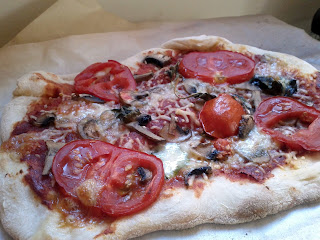There should have been a bread recipe last week; I was all ready to start another sourdough loaf when disaster struck. A wet bowl and some carelessness later, I had dropped my starter (in its Pyrex) to the floor, rending the bowl asunder. A new one has begun, but isn't quite ready. Much food was prepared, though almost all of it from a recipe. To wit:
- Gougères. These were phenomenally easy, smelled like heaven when preparing, and impressed with flavor. I used a strong white cheddar with peppercorns in it and dropped the fennel; my beer was a low percentage (4.5 or so) stout with a strong flavor. Right after baking, they were crispy in all the right ways; the next day, after storage in an airtight container, they had softened.
- Parsnip Latkes. I honestly didn't read the recipe besides ingredients and basic prep, so was surprised by the taste after making these. They are herby little punches in the mouth, especially with the sauce. We made them much larger than suggested (again, not reading very well) and got 4 latkes from a half recipe (should have been double that). Thinner would be crispier and recommended. Actually, just cook these regardless. Quite good.
- Coq au Vin (Julia Child). So, that is how restaurants make those delicious glazes/sauces/etc for their meats. Render bacon fat into butter, cook meat in it; light it on fire with cognac, then add wine and stock. Reduce it an amazing amount, add in a bunch of soft things, and thicken with more butter and some flour. Honestly, it wasn't that much butter/bacon for the serving size (we cut down the butter to something like 4 tbsp total, plus 4 pieces of bacon, for ~4 large-ish meals worth of food). Not that unhealthy when viewed as such.
- Cashew and raisin kale. E made this; it had those three ingredients plus some oil, lemon juice, and salt in a frying pan. It was quite good.
- Oat-berry-rum rubbed apples. I mashed some raspberries with cinnamon and a splash of rum, plus a helping of rolled oats. Rubbed apple slices in it and baked for... 10 minutes? 20 minutes?... in a... somewhat hot oven? I honestly don't remember much; it was good.
- Singed brussels. Blanched the brussels until soft to a fork, sliced in half, tossed with oil and salt, threw on a hot pan face-down until the ridges started to char. Turned down heat, tossed them around for a minute, ate. Good and simple.
E got me two cookbooks; Momofuku and The Cast Iron Skillet Cookbook. The latter is infinitely practical, intended for home cooking. The former is less so, though much more exciting; these are the actual restaurant recipes and prep steps, which means I can learn a hell of a lot about professional cooking vs. "home" cooking. All of the recipes, except the final "Ko" section, seem reasonable to me in terms of ingredients and time commitment. Hopefully I can try it out during New Years, given the free time I'll have.



































